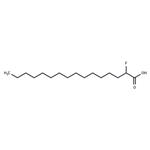Biological Activity
2-fluoropalmitic acid inhibits sphingosine biosynthesis and long-chain acyl-coa synthetase [1]. the length of the carbon chain of the fatty acid species defines the substrate specificity for the different acyl-coa synthetases (acs).mammalian long-chain acyl-coa synthetases (acsl) activate fatty acids with chain lengths of 12 to 20 carbon atoms. the long-chain acyl-coa synthetase mrna is expressed virtually in heart, liver, and epididymal adipose tissues and, to a much lesser extent, in brain, small intestine, and lung [2].palmitic acid was a selective cytotoxic substance extracted from the marine algal. at concentrations ranging from 12.5 to 50 μg/ml, palmitic acid showed selective cytotoxicity to human leukemic cells, but no cytotoxicity to normal hdf cells. palmitic acid (50 μg/ml) induced apoptosis in the human leukemic cell line molt-4. palmitic acid also showed in vivo antitumor activity in mice [3]. 2-fluoropalmitic acid showed an inhibitory effect on sphingosine biosynthesis and long-chain acyl-coa synthetase with an ic50 value of 0.2 mm [1].
References
[1] soltysiak r m, matsuura f, bloomer d, et al. d, l-α-fluoropalmitic acid inhibits sphingosine base formation and accumulates in membrane lipids of cultured mammalian cells[j]. biochimica et biophysica acta (bba)-lipids and lipid metabolism, 1984, 792(2): 214-226.
[2] suzuki h, kawarabayasi y, kondo j, et al. structure and regulation of rat long-chain acyl-coa synthetase[j]. journal of biological chemistry, 1990, 265(15): 8681-8685.
[3] harada h, yamashita u, kurihara h, et al. antitumor activity of palmitic acid found as a selective cytotoxic substance in a marine red alga[j]. anticancer research, 2001, 22(5): 2587-2590.

